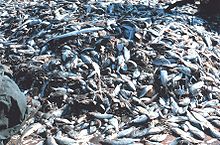
Fishery can mean either the enterprise of raising or harvesting fish and other aquatic life or, more commonly, the site where such enterprise takes place. Commercial fisheries include wild fisheries and fish farms, both in freshwater waterbodies and the oceans. About 500 million people worldwide are economically dependent on fisheries. 171 million tonnes of fish were produced in 2016, but overfishing is an increasing problem, causing declines in some populations.

Trawling is an industrial method of fishing that involves pulling a fishing net, that is heavily weighted to keep it on the seafloor, through the water behind one or more boats. The net used for trawling is called a trawl. This principle requires netting bags which are towed through water to catch different species of fishes or sometimes targeted species. Trawls are often called towed gear or dragged gear.

Bycatch, in the fishing industry, is a fish or other marine species that is caught unintentionally while fishing for specific species or sizes of wildlife. Bycatch is either the wrong species, the wrong sex, or is undersized or juveniles of the target species. The term "bycatch" is also sometimes used for untargeted catch in other forms of animal harvesting or collecting. Non-marine species that are caught but regarded as generally "undesirable" are referred to as rough fish or coarse fish.

Overfishing is the removal of a species of fish from a body of water at a rate greater than that the species can replenish its population naturally, resulting in the species becoming increasingly underpopulated in that area. Overfishing can occur in water bodies of any sizes, such as ponds, wetlands, rivers, lakes or oceans, and can result in resource depletion, reduced biological growth rates and low biomass levels. Sustained overfishing can lead to critical depensation, where the fish population is no longer able to sustain itself. Some forms of overfishing, such as the overfishing of sharks, has led to the upset of entire marine ecosystems. Types of overfishing include growth overfishing, recruitment overfishing, and ecosystem overfishing.
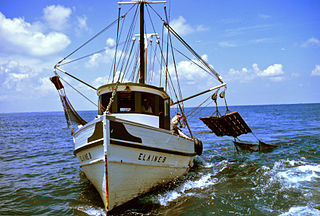
The fishing industry includes any industry or activity that takes, cultures, processes, preserves, stores, transports, markets or sells fish or fish products. It is defined by the Food and Agriculture Organization as including recreational, subsistence and commercial fishing, as well as the related harvesting, processing, and marketing sectors. The commercial activity is aimed at the delivery of fish and other seafood products for human consumption or as input factors in other industrial processes. The livelihood of over 500 million people in developing countries depends directly or indirectly on fisheries and aquaculture.

Gillnetting is a fishing method that uses gillnets: vertical panels of netting that hang from a line with regularly spaced floaters that hold the line on the surface of the water. The floats are sometimes called "corks" and the line with corks is generally referred to as a "cork line." The line along the bottom of the panels is generally weighted. Traditionally this line has been weighted with lead and may be referred to as "lead line." A gillnet is normally set in a straight line. Gillnets can be characterized by mesh size, as well as colour and type of filament from which they are made. Fish may be caught by gillnets in three ways:
- Wedged – held by the mesh around the body.
- Gilled – held by mesh slipping behind the opercula.
- Tangled – held by teeth, spines, maxillaries, or other protrusions without the body penetrating the mesh.

Commercial fishing is the activity of catching fish and other seafood for commercial profit, mostly from wild fisheries. It provides a large quantity of food to many countries around the world, but those who practice it as an industry must often pursue fish far into the ocean under adverse conditions. Large-scale commercial fishing is called industrial fishing.
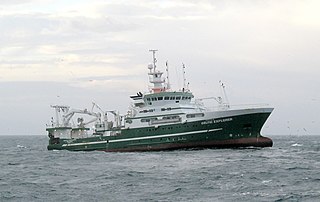
Bottom trawling is trawling along the seafloor. It is also referred to as "dragging". The scientific community divides bottom trawling into benthic trawling and demersal trawling. Benthic trawling is towing a net at the very bottom of the ocean and demersal trawling is towing a net just above the benthic zone. Bottom trawling can be contrasted with midwater trawling, where a net is towed higher in the water column. Midwater trawling catches pelagic fish such as anchovies and mackerel, whereas bottom trawling targets both bottom-living fish (groundfish) and semi-pelagic species such as cod, squid, shrimp, and rockfish.

Blast fishing, fish bombing, dynamite fishing or grenade fishing is a destructive fishing practice using explosives to stun or kill schools of fish for easy collection. This often illegal practice is extremely destructive to the surrounding ecosystem, as the explosion often destroys the underlying habitat that supports the fish. The frequently improvised nature of the explosives used, and undetonated charges, means danger for fishermen and divers as well, with accidents and injuries.
The Experimental Oculina Research Reserve preserves the Oculina Banks, a reef of ivory bush coral off the coast of Fort Pierce, Florida. Oculina varicosa is a U.S. National Marine Fisheries Service species of concern. Species of concern are those species about which the U.S. Government's National Oceanic and Atmospheric Administration (NOAA), National Marine Fisheries Service, has some concerns regarding status and threats, but for which insufficient information is available to indicate a need to list the species under the U.S. Endangered Species Act (ESA).
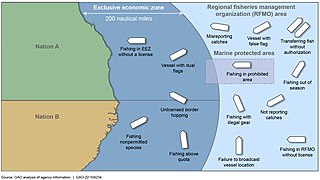
Illegal, unreported and unregulated fishing (IUU) is an issue around the world. Fishing industry observers believe IUU occurs in most fisheries, and accounts for up to 30% of total catches in some important fisheries.

The environmental impact of fishing includes issues such as the availability of fish, overfishing, fisheries, and fisheries management; as well as the impact of industrial fishing on other elements of the environment, such as bycatch. These issues are part of marine conservation, and are addressed in fisheries science programs. According to a 2019 FAO report, global production of fish, crustaceans, molluscs and other aquatic animals has continued to grow and reached 172.6 million tonnes in 2017, with an increase of 4.1 percent compared with 2016. There is a growing gap between the supply of fish and demand, due in part to world population growth.

Fishing techniques are methods for catching fish. The term may also be applied to methods for catching other aquatic animals such as molluscs and edible marine invertebrates.

A wild fishery is a natural body of water with a sizeable free-ranging fish or other aquatic animal population that can be harvested for its commercial value. Wild fisheries can be marine (saltwater) or lacustrine/riverine (freshwater), and rely heavily on the carrying capacity of the local aquatic ecosystem.
This is a glossary of terms used in fisheries, fisheries management and fisheries science.
Destructive fishing practices are fishing practices which easily result in irreversible damage to habitats and the sustainability of the fishery ecosystems. Such damages can be caused by direct physical destruction of the underwater landform and vegetation, overfishing indiscriminate killing/maiming of aquatic life, disruption of vital reproductive cycles, and lingering water pollution.

As with other countries, the 200 nautical miles (370 km) exclusive economic zone (EEZ) off the coast of the United States gives its fishing industry special fishing rights. It covers 11.4 million square kilometres, which is the second largest zone in the world, exceeding the land area of the United States.
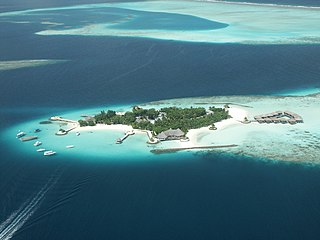
The fishing industry in the Maldives is the island's second main industry. According to national tradition in the words of former President Maumoon Abdul Gayoom, "Fishing is the lifeblood of our nation, it is inborn. From the soil on which we live, to the sea around us, it remains an integral part of our existence. Fishing, and our country and its people, [are] one and shall remain inseparable forever." The Maldives has an abundance of aquatic life and species of fish. Common are tuna, groupers, dolphin fish, barracuda, rainbow runner, trevally and squirrelfish and many more. Aside from being of essential importance to the economy, fishing is also a popular recreational activity in the Maldives, not only among locals but by tourists. The islands have numerous fishing resorts which cater for these activities.

Fisheries are affected by climate change in many ways: marine aquatic ecosystems are being affected by rising ocean temperatures, ocean acidification and ocean deoxygenation, while freshwater ecosystems are being impacted by changes in water temperature, water flow, and fish habitat loss. These effects vary in the context of each fishery. Climate change is modifying fish distributions and the productivity of marine and freshwater species. Climate change is expected to lead to significant changes in the availability and trade of fish products. The geopolitical and economic consequences will be significant, especially for the countries most dependent on the sector. The biggest decreases in maximum catch potential can be expected in the tropics, mostly in the South Pacific regions.

The Western Pacific Regional Fishery Management Council (WPRFMC) is one of eight regional councils established under the Magnuson-Stevens Fishery Conservation and Management Act (MSA) in 1976 to manage offshore fisheries. The WPRFMC's jurisdiction includes the US exclusive economic zone (EEZ) waters around the State of Hawaii; US Territories of American Samoa and Guam; the Commonwealth of the Northern Mariana Islands (CNMI); and the US Pacific remote island areas of Johnston, Midway, Palmyra and Wake Atolls; Baker, Howland and Jarvis Islands; and Kingman Reef. This area of nearly 1.5 million square miles is the size of the continental United States and constitutes about half of the entire US EEZ. It spans both sides of the equator and both sides of the dateline. The WPRFMC also manages domestic fisheries based in the US Pacific Islands that operate on the high seas.


![The blast radius of an explosive device being set off underwater to obtain fish (dynamite fishing) toottttyittttullll mii[?] pittuttN.jpg](http://upload.wikimedia.org/wikipedia/commons/thumb/c/ca/%E0%B4%A4%E0%B5%8B%E0%B4%9F%E0%B5%8D%E0%B4%9F%E0%B4%AF%E0%B4%BF%E0%B4%9F%E0%B5%8D%E0%B4%9F%E0%B5%81%E0%B4%B3%E0%B5%8D%E0%B4%B3_%E0%B4%AE%E0%B5%80%E0%B5%BB_%E0%B4%AA%E0%B4%BF%E0%B4%9F%E0%B5%81%E0%B4%A4%E0%B5%8D%E0%B4%A4%E0%B4%82.jpg/220px-%E0%B4%A4%E0%B5%8B%E0%B4%9F%E0%B5%8D%E0%B4%9F%E0%B4%AF%E0%B4%BF%E0%B4%9F%E0%B5%8D%E0%B4%9F%E0%B5%81%E0%B4%B3%E0%B5%8D%E0%B4%B3_%E0%B4%AE%E0%B5%80%E0%B5%BB_%E0%B4%AA%E0%B4%BF%E0%B4%9F%E0%B5%81%E0%B4%A4%E0%B5%8D%E0%B4%A4%E0%B4%82.jpg)

